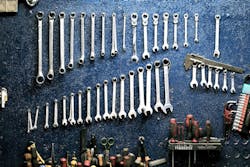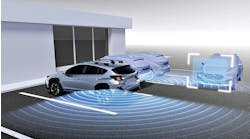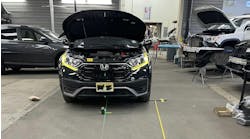Technology is advancing at an exponential rate, and it’s having a huge impact on the world at large, including the collision repair industries, says Alex Sun, Mitchell president and CEO.
In the third quarter 2018 Mitchell Industry Trends Report, Sun discusses how technology is changing the nature of insurance risk in the age of automation. He delves deeper into the concept known as the Internet of Things (IoT).
The Internet of Things is the network of devices, vehicles, appliances and other items embedded with electronics, software, and connectivity, which enables these items to connect and share data. According to Huffington Post, one of the important areas within IoT is the automotive industry and the connected car that has taken off in today’s age. And, according to a study by Gartner in 2016, the production of cars equipped with data connectivity is predicted to reach 61 million in 2020.
Today’s connected cars are outfitted with complex advanced driver-assistance systems (ADAS)—forward collision detection, lane departure warnings, and adaptive cruise control. Central to these systems are sensors that track what’s going on both in and around the vehicle.
While technology has potential to make cars safer, it also makes the repair more complex.
“The Internet of Things is just one of many technology trends that is top of mind for us,” Sun says.
Sun joined Mitchell in 2001 and currently guides the business’ strategy and day-to-day operations. Before becoming CEO, Sun served as president and chief financial officer for Mitchell. Before his time at Mitchell, Sun worked with Merrill Lynch & Co., and an enterprise software company that is now part of the SAS Institute.
In terms of vehicle sensors, how many could a vehicle have within a few years? At what rate is it growing?
We live in a world in which virtually everything has the potential to have a sensor embedded in it that produces data about its environment and shares that data out. It is not unusual for a new car to have upward of 200 sensors that do things like monitor engine function and support advanced driver-assistance systems. I think we are going to see strong growth in both the number and types of sensors that are embedded in vehicles.
I see a future where cars are hubs of information, collecting data about the world around them—traffic, road conditions, even weather—and distributing that information to a larger network that evaluates the data and returns it to the driver in the form of useful insights. For instance, traffic data crowdsourced from vehicle sensors could inform suggested routes for drivers to take.
What are the risks that come with the possibility for cars to be a hub of information technology?
As vehicles become more connected, and, ultimately, autonomous, the number of sensors embedded in them will likely grow, and those sensors will be a source of data and in some cases an access point into the vehicle. With increased connectivity comes increased security risk: not only will it be important to secure certain sensors as entry points into on board computer systems, it may be important to secure data coming from the vehicle.
Data collected by a vehicle around location, traffic, road conditions, weather, and even driver behavior could be used to provide insights to other drivers, but questions remain about who owns this data, what can be shared, and even if and how it can be monetized.
Further, as more data comes into the vehicle—not just about weather, road conditions, and traffic, but perhaps even advertising—it will be important to manage the way that information is supported, rather than distracting the driver.
Perhaps one of the most important risks I see, and top of mind at Mitchell, is that as vehicles become increasingly sophisticated, they also become more complex to repair. It’s a primary focus for us, and our auto physical damage business unit considers proper and safe repair its “true north.” One important focus for us is supporting insurers and collision repair facilities by providing them the right information, when and where they need it, to help ensure vehicles are repaired properly and safely.
How does IoT impact the claims process?
When a vehicle has been damaged in an accident, I see embedded sensors as another source of data to inform what type of damage has occurred. That data could conceivably be used to inform the estimating and repair process, making it more efficient and accurate—a win for insurers, collision repair facilities, and consumers alike. Further, when the data is coupled with data from other sources, it could provide insights to insurers that help them make better decisions, both around individual claims and around their businesses as a whole.
For instance, combined physical damage and bodily injury data may help insurers identify patterns and anomalies around the likelihood of certain types of injuries.
What can shop owners expect to see in terms of IoT? Could it potentially reduce the cost of repairs?
As vehicles become more sophisticated, they also become increasingly complex to repair. For now, we’re seeing that drive the price of repairs up. It’s not just IoT-related technology that’s behind this trend. Things like special materials play into it, too.



